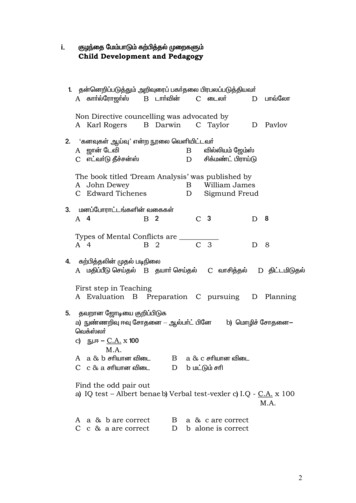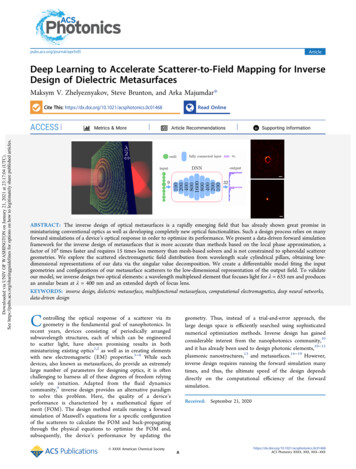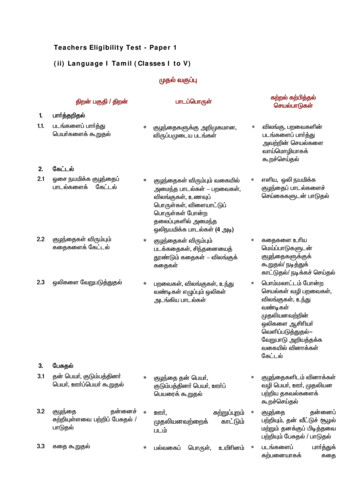
Transcription
i.FHªij nk«ghL« f‰Ã jš KiwfS«Child Development and Pedagogy1. j‹bd¿ gL J« m¿Îiu gf jiy Ãugy gL Âat A fh šnuh# B lh é‹C ily DNon Directive councelling was advocated byA Karl RogersB DarwinC Taylor2.gh›nyhDPavlov‘fdÎfŸ MŒÎ’ v‹w üiy btëæ lt éšèa« n#« A #h‹ nléBÁ¡k ÃuhŒLC v t L Ô r‹ DThe book titled ‘Dream Analysis’ was published byA John DeweyBWilliam JamesC Edward TichenesDSigmund Freud3.kd nghuh l§fë‹ tiffŸA 4B 2C 3Types of Mental Conflicts areA 4B 2C 34.f‰Ã jè‹ Kjš goãiyA k ÕL brŒjš B jah brŒjšFirst step in TeachingA Evaluation B Preparation5.D8D8C thÁ jšC pursuingD  läLjšDPlanningjtwhd n#hoia F¿ ÃLfa) E z¿Î Î nrhjid – Mšg Ãndb) bkhê nrhjidbt¡ y c) E. - C.A. x 100M.A.A a & b rçahd éilB a & c rçahd éilC c & a rçahd éilD b k L« rçFind the odd pair outa) IQ test – Albert benae b) Verbal test-vexler c) I.Q - C.A. x 100M.A.A a & b are correctC c & a are correctBDa & c are correctb alone is correct2
6.fUÎWjè‹nghJ MâläUªJ bgw gL« Fnuhnkhnrh«A YB XC XYD XXDuring fertilization the chromosome received from the malepartner isA YB XC XYD XX7.E z¿Î rh ªj g‹Kf¡fhuâ¡ nfh gh oid msél jh il¡TW« tê ahJ?A CVADB CAVDC CDAVD CDVAName the test deviced by Thorndike in multiple theory ofIntelligenceA CVADB CAVDC CDAVD CDVA8.9.ö lš-Jy§fš V‰gl¡ fhuz«A isB K ÁC òy‹ cW òfŸDStimulus – response is due toA BrainB Maturity C Sense organsD ExperiencemDgt§fŸABnkny fhQ« ÏU nfhLfëš ‘A’ v‹w nfhL ‘B’ ia él Ús« FiwªJfhQ« fh Áæid vdyh«A ghŒf‹lh Âçò¡ fh ÁB gL¡if ne nfhL Âçò¡ fh ÁC nršd Âçò¡ fh ÁD Kšy -ya Âçò¡ fh ÁABIn the above figure the line ‘A’ is perceived to be shorter than theline ‘B’. This is due toA Poyendoffs illusion B Horizontal – Vertical line illusionC Zollener’s illusionD Muller-Lyer illusion10. Fku gUt« xU Á¡fyhd mikÂa‰w gUt« vd¡ T¿at A à ¡r‹ B nfhš C lh‹è Ahš D éšèa« k¡ fšAdolescence is a period of storm and stress – said byA Brickson B Cole C Stanley Hall D William Mcdougall11.clš brašghLfŸ k‰W« cs brašghLfŸ Ïu oidÍ« Óuhf brašgl cjΫ K¡»a ehsäšyh Ru ÃA à ô lç Ru ÃB ijuhŒL Ru ÃC ghuhijuhŒL Ru ÃD m ßdš Ru Ã3
The main ductless gland that regulates the physiological andpsychological functioning of a person isA The pituitary glandB Thyroid glandC Para thyroid glandD Adrenal gland12. e«Kila jhija fëläUªJ bjhl ªJ tê têahf clš,cs g òfŸ Ë rªjÂfS¡F É‹fë‹ ykhf tUjiyvd miH¡»‹nwh«A gçzhk ts ÁB mL j rªj ãiy kh‰w«C cæçaš kuò ãiyD Ït‰¿š vJÎäšiyThe transfer of physiological and genetic characters fromparents to off springs through generations is calledA EvolutionB Transfer to next generationC Biological heridityD None of the above13. xU fU Ïu ila fŸ xnu NHèš ts ªjnghJ, Ït fëilnaE z¿Î Î (r)A r 0.087 B r 0.0870C r 0.87D r 8.7The IQ correlation (r) of monozygotic twins, brought up in thesame environment isA r 0.087 B r 0.0870C r 0.87D r 8.714. Ãahn#æ‹ m¿jš Âw‹ ts Áæ‹ ‹wh« ãiyA kd brašgh L¡F Kªija ãiyB f Tlhf gh gij it J ÁªÂ J brašgL« ãiyC bjh L czU« gUt«D Kiwahf nahÁ J ÁªÂ J v z§fë‹ mo gilæš brašgL«kdãiyAccording to piaget is the 3rd stage in the cognitivegrowth of an individualA Pre-operational stageB Concrete operational stageC Sensory Motor stageD Formal operational stage15. c fh Á y« f‰wiy Kj‹ Kjèš és¡»at A B.F. »‹d B nkç fÎ n#h‹ C gh›nyh DLearning through insight was first shown byA B.F. SkinnerB Mary Kavur JonesCnfhy Pavlov D Kohler16. jtW brŒÍ« khztid ÂU j V‰wJA j lidB eštê fh LjšC gçRfŸ më jšD f L bfhŸshkš é L éLjš4
The best way to change the wrong doing of a child is byA PunishmentC by giving awardsBDTeaching good moral valuesignoring his behaviour17. E z¿Î K Á bghJthf KGik bgU« taJA 10-11B 19-20C 40-41DIntelligence attains its maximum level at the age ofA 10-11B 19-20C 40-41D15-1615-1618. M¡fÂw‹ g‰¿a ä‹dnrhlh nrhjidæ‹ (bkhê k‰W«bkhêæšyh nrhjid) cU gofŸ v jidA 10B 14C 12D 19State the total number of creativity tests (Verbal Non verbal) inMinnesota test of thinkingA 10B 14C 12D 1919. mfKf‹, òwKf‹ M»nahuJ Ïašòfis és¡»at A nf lšB Ir‹¡C bf« DͧPersonality traits such as introvertism and extrovertismpersonality was explained byA CattellB EysenckC KempD Yung20. MSikia msél ga‹gL« äf bghU jkhd KiwA RarçijB Ra k ÕLC kWbkhê nfhUgitD kd gh‹ik msÎnfhšThe most apt method of evaluating a person’s personality isthroughA AutobiographyBSelf ratingC QuestionnaireD Attitude scale21. äif ãiy kd« v‹w ãiy vªj taÂdU¡F V‰gL»wJA 1-3B 3-6C 6-9D 9-12Super ego stage occurs at the age ofA 1-3B 3-6C 6-9D9-1222. ò% l¡khå‹ MÁça ju msÎ nfhèid ga‹gL ÂÑœ¡F¿ Ãl g LŸs v g Ãid MÁçaçl« msÅL brŒayh«A MÁçaç‹ el ij k‰W« M¡f g òB MÁçaç‹ gçÎ k‰W« V‰òC MÁçaç‹ Ïa§F« g ò k‰W« el ijD Ïit mid J«5
Which of the following can be evaluated using Bruce Tuckman’sTeacher Feedback formA Behaviour & CreativityC Dymanism & OrganiseddemeanorBDWarmth & acceptanceAll the above23. Aš v‹gtuJ f‰wš bfhŸifæid F¿¡F« N Âu« ahJA SER DRXSH x K – IBRES DXSRH x K - IEHC S R XDSR R x K - IDSER DXSHR x K - IHull’s theory of learning formulae isA SER DRXSH x K – IBC SER XDSRHR x K - IDRES DXSRH x K - ISER DXSHR x K - I24. isæš V‰gL« ãidé‰F äf K¡»a fhuzkhf Ïa§F«nt bghUŸfh nghiAonu A o.v‹.V.B M .v‹.V. C òuj«DThe most potential chemical agent responsible for memory isA D.N.A.BR.N.A.C ProteinsD Carbohydrates25. fhy taJ 8, kd taJ 7 k‰W« fhy taJ 7, kd taJ 8 cŸsÏ›éUtç‹ E z¿Î Î ahJ?A 87.5 & 114.5B 85.7 & 141.5C 8.75 & 11.45D 875 & 114The Chronological age of one child is 8, Mental age is 7 andanother child is with C.A. 7 & M.A. 8, find out their I.Q. Level.A 87.5 & 114.5B 85.7 & 141.5C 8.75 & 11.45D 875 & 11426. ïè v‹gt 1909M« M L ãWéa FHªijfŸ cs ey kU JtéL v§F mikªJŸsJA M ÂnuèahB ϪÂahC Á¡fhnfhD rΠmnuÃahIn which country was the Juvenile Psychopathic Instituteestablished in the year 1909A AustraliaB IndiaC ChicagoD Saudi Arabia27. ftd Å ir ms¡f cjΫ fUéA fiylh nfh B Motiu nrhjid fUéC lhÁ lh nfh D ãidÎ, cUis fUéThe device used to measure the span of attention isA KaliedascopeBMirror drawing apparatusC TachistascopeDMemory drum apparatus6
28. uhg fh¡nd v‹gtuJ T‰W go f‰wš v‹gJgoãiyfis bfh lJA 5B 7C 8D 6Robert Gagne’s theory of Hierarchial learning includestypes of learningA 5B 7C 8D 629. ãidé‹ K¡»a Ïu L tiffŸA STM & LTM B ATM & GTMC LTM & ATMD ATM & STMThe two types of memory areA STM & LTM B ATM & GTMC LTM & ATMD ATM & STM30. VIBGYOR v‹gJ v‹gj‰F xU Áwªj vL J¡fh LA RU§f f‰wš B ãidÎ N Âu§fŸ C vëa f‰wš D nkhå¡ VIBGYOR is a good example ofA abbrevation B Mnemonicsii.Ceasy learningDmonicsLanguage I – jäœ - TamilÑœ cŸs g Âia go J 1 Kjš 3 tiu cŸs édh¡fS¡F éilaë¡f.jäœ eh oš r§f fhy ‰F K‹dnu Xéa§fŸ tiua g ld. jh«tiuªjXéa§fisKjèšf bzG Jv‹nwtH§»d .jäœÏy¡»a š vG J v‹gj‰F Xéa« v‹W« bghUŸ cŸsJ. ne ¡nfhL,nfhz¡nfhL, tisnfhL bfh L tiua g l Xéa§fŸ nfh nlhéa§fŸvd gL«. Xéa fŸ v z§fë‹ vG Áia gy t z§fë‹ Jizbfh L vGJnthuhjè‹ f QŸ éidP vd g ld . M Xéa ‘Á juh§fj‹’ vdΫ, bg Xéa ‘Á Âunrdh’ vdΫ miH¡f gLt .31. tisnfhLfŸ bfh L tiua gLtJA vGjh Xéa«B nfh nlhéa«C òidah Xéa«D ghit Xéa«32. ‘f QŸ éidP ’ v‹wiH¡f gLgt A òyt B ghlf C eh oa¡fhu D Xéa 7
A STM & LTM B ATM & GTM C LTM & ATM D ATM & STM The two types of memory are A STM & LTM B ATM & GTM C LTM & ATM D ATM & STM 30. VIBGYOR v‹gJ _ v‹gj‰F xU Áwªj vL J¡fh L A RU§f f‰wš B ãidÎ N Âu§fŸ C vëa f‰wš D nkhå¡ VIBGYOR is a good example of A abbrevation B Mnemonics C easy learning D monics ii.

